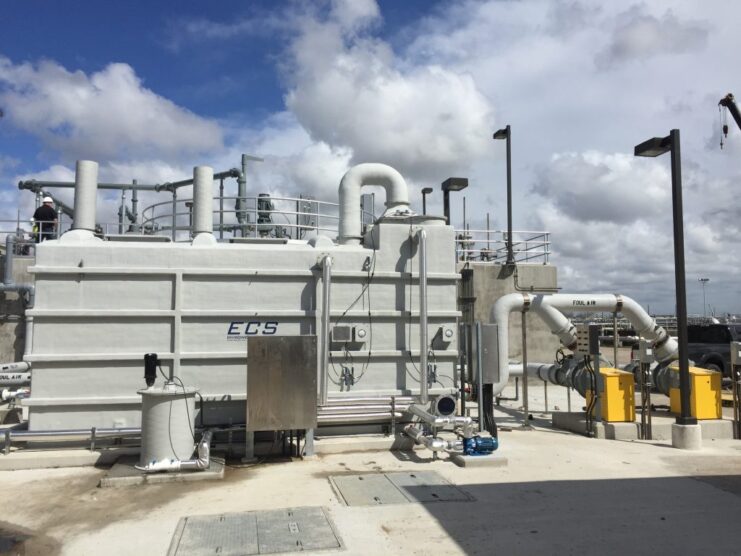Unpleasant smells in industrial settings are more than just a nuisance, they can have a significant impact on staff wellbeing, community relations, and compliance with environmental regulations.
Effective odour control is essential for maintaining a safe, comfortable, and legally compliant workplace. By tackling odours at their source, businesses can protect their reputation, ensure operational efficiency, and promote a healthier working environment.
Why Odour Control Matters
Odours are caused by airborne molecules released during industrial processes such as food production, waste treatment, chemical manufacturing, and composting. While some smells are merely unpleasant, others can indicate the presence of harmful compounds.
Poor odour management can lead to:
- Employee discomfort – Persistent bad smells can lower morale and increase absenteeism.
- Community complaints – Neighbouring residents and businesses may object to odours drifting beyond site boundaries.
- Regulatory issues – Many industries must comply with environmental guidelines that limit odour emissions.
The Wider Health and Social Implications of Odour

Beyond the immediate annoyance, odours can trigger headaches, nausea, or respiratory irritation among workers and nearby residents. Sensitive groups such as children, elderly people, and individuals with asthma are particularly vulnerable to poor air quality.
On a community level, odour problems can strain relations between companies and their neighbours, leading to distrust and even protests. Once a business develops a reputation for polluting the local environment, it can be extremely difficult to repair that image.
In some cases, odour complaints have even delayed expansion plans or forced businesses to relocate.
This demonstrates that odour control is not only a technical issue but also a matter of public relations and corporate responsibility.
How Odour Control Works
Modern odour control solutions target and neutralise odours before they escape into the surrounding environment. These systems use a combination of technologies to capture, filter, and treat contaminated air. Common methods include:
- Activated carbon filtration – Adsorbs odorous compounds onto a carbon surface.
- Wet scrubbing – Uses liquid to remove gases and particles from the air.
- Biofiltration – Employs natural microorganisms to break down odour molecules.
- Chemical scrubbing – Uses chemical reactions to neutralise odorous gases.
Each method has its advantages, and many industrial sites benefit from a tailored solution that combines multiple technologies.
Why a Tailored Approach is Important

Every industrial site is unique, which means odour control cannot be approached with a one-size-fits-all mindset. The type of processes being carried out, the volume of emissions, and even the layout of the facility influence which technologies will work best.
For instance, a food processing plant dealing with organic waste may benefit most from biofiltration, while a chemical plant with solvent emissions might require chemical scrubbing.
Costs and maintenance demands also vary between systems, making professional consultation a key part of choosing the right approach. By combining different technologies, companies can achieve more consistent results while reducing long-term expenses.
Ultimately, tailoring odour control ensures that businesses remain compliant while gaining operational efficiency.
Industry Applications
Odour control is vital in a wide range of industries, including:
- Food and beverage manufacturing – Controlling smells from cooking, fermentation, or waste products.
- Waste management and recycling – Preventing odours from organic decomposition.
- Water and wastewater treatment – Eliminating sewage and chemical smells.
- Chemical processing – Managing odours from solvents and other compounds.
Community Relations and Industry Reputation
Industries that fail to control odours often find themselves at the centre of community disputes. For example, waste management sites are frequently targeted by resident complaints when odour spreads into nearby housing areas.
Food manufacturers, breweries, and chemical plants also face similar challenges. These complaints can escalate into formal investigations by local authorities, resulting in penalties or operational restrictions.
On the other hand, businesses that take odour control seriously can foster better relationships with their communities, strengthening their social license to operate.
In competitive industries, demonstrating a commitment to environmental responsibility can even become a selling point, helping companies win contracts or maintain customer loyalty. In short, odour management is as much about protecting reputation as it is about controlling emissions.
Benefits Beyond Smell Reduction

While the primary goal is to reduce or eliminate unpleasant smells, effective odour control offers additional benefits:
- Improved air quality – Reducing airborne contaminants creates a healthier workplace.
- Enhanced brand reputation – Businesses that manage odours well demonstrate environmental responsibility.
- Regulatory compliance – Meeting environmental standards helps avoid fines and enforcement action.
- Operational efficiency – Clean air can improve equipment performance and reduce corrosion from acidic vapours.
The Long-Term Business Case for Odour Control
Investing in odour control may seem like an additional expense at first, but in reality, it often saves money over time. Clean air reduces corrosion on sensitive equipment, lowering repair and replacement costs.
Healthier employees mean fewer sick days and greater productivity. Businesses that avoid fines or shutdowns due to non-compliance also protect their bottom line.
Moreover, in today’s sustainability-focused market, companies that demonstrate environmental stewardship are more likely to attract clients, investors, and skilled workers.
In this sense, odour control is not merely about removing unpleasant smells – it is a strategic investment that contributes to growth, competitiveness, and resilience in the long run.
Choosing the Right Odour Control Solution
Selecting the right system requires a clear understanding of your processes, odour sources, and operational requirements. A professional assessment can help determine the most effective and cost-efficient approach, whether it’s a single-technology system or a fully integrated odour and emissions management solution.
Partnering with experts such as Exeon ensures that your odour control system is designed to meet both current needs and future regulatory requirements.
Balancing Innovation and Compliance

One of the biggest challenges for businesses is keeping pace with evolving environmental regulations. A solution that meets today’s standards may fall short as new legislation is introduced.
That’s why modern odour control must balance immediate needs with future-proofing. Companies that partner with experienced providers gain access to innovative systems that are scalable and adaptable.
This reduces the risk of having to reinvest in entirely new infrastructure every time compliance standards shift.
In addition, advanced monitoring tools allow real-time measurement of emissions, enabling businesses to respond proactively before problems escalate.
By combining technology with strategic planning, businesses can ensure long-term compliance and operational security.
Conclusion
Odour issues in industrial environments should never be overlooked. By investing in effective odour control, businesses can protect employee health, maintain strong community relationships, and stay compliant with environmental regulations.
With the right solution in place, industrial sites can operate more efficiently, sustainably, and with far greater peace of mind.

